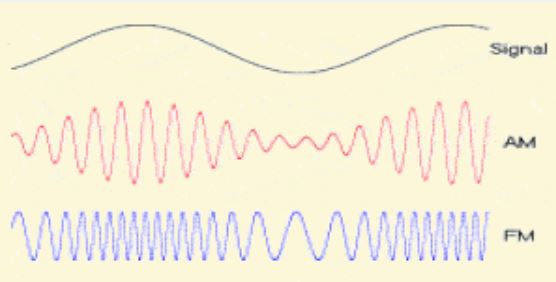
| Practical Radio Signal Modulation And Their Variants |

Typical analog baseband signals are in the form of continually varying voltage in accordance with the original analog source. It may be the voltage output from a microphone in the case of voice, music, etc. In the case of pictures and videos, the baseband voltage signal is typically derived from camera output and so on. However, if the baseband information is digital then it might have several discrete steps of voltage levels. In the case of the commonly used binary digital information signal, the baseband voltage only two distinct voltage levels. The ongoing pattern of alteration of voltage levels between the two binary states determine the baseband signal. The methods of modulation in the case of digital signals also remain the same as that of analog modulation. The only difference being that instead of continuous voltage level variations, we now have step variations. In the case of binary information, the number of steps is two. Therefore, the amplitude, frequency, or phase shifts produced in binary digital modulation have only two steps. Consequently, the AM, FM, or PM modulated carrier-envelope also has two levels of RF carrier-envelope variations. Since the modulation attributes of the RF carrier now appear to shift between two possible states, the digital forms of radio signal modulation are generally referred to as Amplitude Shift Keying (ASK), Frequency Shift Keying (FSK), and Phase Shift Keying (PSK) that correspond to AM, FM, or PM as applicable to analog modulation forms respectively. Find out more about digital signal modulation in the article on Digital Modulation Fundamentals. 
The modulation process of the RF carrier principally remains the same for both the analog as well as digital modulations. All the modulation modes that we have discussed so far can be practically implemented in analog form (irrespective of digital or analog baseband information source) by electronic circuits, where controlling and varying various electronic circuit parameters. Electronic circuits may be designed and configured in various ways to achieve the objective of modulation. For instance, AM may be produced simply by varying the gain of an amplifier according to the baseband signal voltage. Similarly, FM may be produced by varying the frequency of the carrier oscillator using a specific combination of electronic components in an oscillator circuit. There are many other ways of achieving these objectives through different types of electronic circuits. However, it is important to note that the modulation processes of all types have a method to the madness. They are not just random intuitive processes but they all have distinct and definite mathematical correlations. In other words, every form of radio signal modulation follows a mathematical model and can be expressed and defined by mathematical equations. This brings out a very interesting aspect of modulation. Not only can radio signal modulation irrespective of AM, FM, PM, ASK, FSK, PSK, or other complex variants be produced by traditional analog circuit implementations, they can also be produced by digital computer algorithms that process the associated mathematical equations in real-time. The high-speed modern computers (including PC) or specially designed dedicated digital electronic circuits like Field-Programable Gate Arrays (FPGA), Digital Signal Processors (DSP), or Application-Specific Integrated Circuits (ASIC), etc including high-performance microprocessors may typically be used to undertake the process of both radio signal modulation and demodulation. Although the traditional methods of using analog electronic circuits for modulation and demodulation is commonly used in most of the radio equipment for amateur radio use, in the modern-day and age, more and more equipment are now being built that use hardware-based mathematical digital signal processing to achieve these objectives. Such algorithmic implementations form the backbone of Software Defined Radios (SDR). In this article, however, I will cover only the fundamentals based on traditional methods. I will keep the narrative simple and intuitive and stress only on the core fundamentals of the concepts. Subsequently, in follow-up articles under this section, I will dwell into to the finer aspects including digital methods of radio signal modulation. |
| Leave Message |
|
Message Has Been Sent Successfully
|

